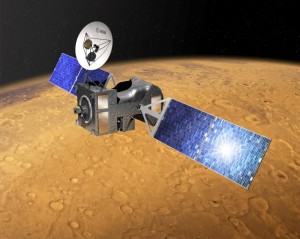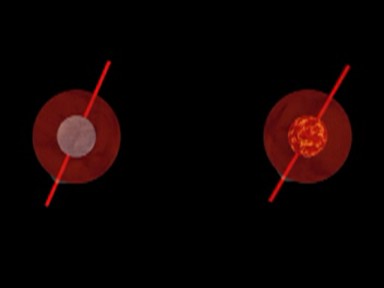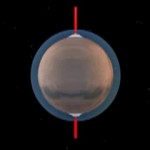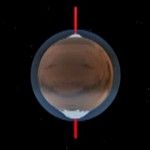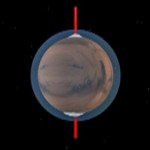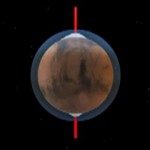The Belgian instrument LaRa (for Lander Radioscience) has been selected for the ExoMars Platform 2018
Introduction
The European Space Agency (ESA) in collaboration with the Russian Federal Space Agency (Roscosmos) has chosen the set of instruments to be put on the ExoMars platform to be launched in 2018. This platform is part of the ExoMars mission that will deliver in 2019 the ESA-built rover to the Martian surface. Among the chosen instruments is the Belgian transponder LaRa (for Lander Radioscience).
Concept
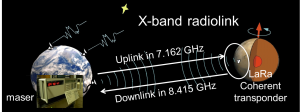 LaRa uses X-band 1 radio signals between the lander and the Earth. It sends the signal received from Earth back to large ESA and NASA antennas on Earth. Measurements of the Doppler shift on the radio link between LaRa on Mars and the antennas on Earth will be used to determine the rotation and orientation of Mars in space with a precision never reached before. This is possible since the rotation and orientation of the Earth are almost perfectly (precision below the centimeter level) known in space and the lander is fixed to the surface of Mars. The transponder has been designed by the Belgian company Orban Microwave Products (OMP) with funding from BELSPO (Belgian Federal Science Policy Office) via the PRODEX Programme of ESA (PROgramme for the Development of scientific EXperiments).
LaRa uses X-band 1 radio signals between the lander and the Earth. It sends the signal received from Earth back to large ESA and NASA antennas on Earth. Measurements of the Doppler shift on the radio link between LaRa on Mars and the antennas on Earth will be used to determine the rotation and orientation of Mars in space with a precision never reached before. This is possible since the rotation and orientation of the Earth are almost perfectly (precision below the centimeter level) known in space and the lander is fixed to the surface of Mars. The transponder has been designed by the Belgian company Orban Microwave Products (OMP) with funding from BELSPO (Belgian Federal Science Policy Office) via the PRODEX Programme of ESA (PROgramme for the Development of scientific EXperiments).
Context
ExoMars (Exobiology on Mars) is a large Mars mission to search for biosignatures of Martian life, past or present. This astrobiology mission is currently under development by the European Space Agency (ESA) in collaboration with the Russian Federal Space Agency (Roscosmos). The programme includes several spacecraft elements to be sent to Mars on two launches.
(1) The ExoMars Trace Gas Orbiter (TGO) and the Entry, descent and landing Demonstrator Module (EDM) called “Schiaparelli” are planned for a launch in 2016. The TGO has four instruments to map the sources of methane on Mars and other gases. One of these instruments is the Belgian instrument NOMAD (Nadir and Occultation for MArs Discovery). TGO will also act as the communication relay satellite for the follow up ExoMars elements.
(2) In 2018 a Roscosmos-built lander will deliver the ESA-built rover to the martian surface. The lander and the rover will include some European and Russian instruments.
ESA and Roscosmos have recently made a call for European instruments for the 2018 platform. The Belgian instrument LaRa (for Lander Radioscience) has been selected and will be the first Belgian instrument on the surface of Mars.
Purpose of the instrument
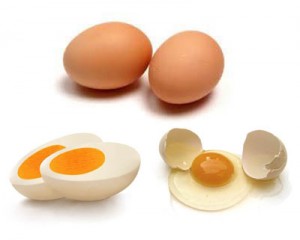 Understanding the structure of and processes in the deep interior of planets is crucial for learning about the origin and evolution of planets. As deep planetary interiors are inaccessible to direct observation, the most effective way to explore them is through geophysics, which can be used as a tool for “remote sensing” of the interior. The four major classes of geophysical techniques that are used to probe planetary interiors are seismology, geodesy, heat flow measurements, and electro-magnetism. The LaRa (Lander Radioscience) team proposes a radioscience geodesy experiment to precisely measure the rotation and orientation of Mars. Most of us know that the rotation of a boiled egg noticeably differs from that of a raw egg. This simple observation shows that information on the inside of an egg can be obtained from its rotation. The same idea applies to the rotation and orientation of Mars.
Understanding the structure of and processes in the deep interior of planets is crucial for learning about the origin and evolution of planets. As deep planetary interiors are inaccessible to direct observation, the most effective way to explore them is through geophysics, which can be used as a tool for “remote sensing” of the interior. The four major classes of geophysical techniques that are used to probe planetary interiors are seismology, geodesy, heat flow measurements, and electro-magnetism. The LaRa (Lander Radioscience) team proposes a radioscience geodesy experiment to precisely measure the rotation and orientation of Mars. Most of us know that the rotation of a boiled egg noticeably differs from that of a raw egg. This simple observation shows that information on the inside of an egg can be obtained from its rotation. The same idea applies to the rotation and orientation of Mars.
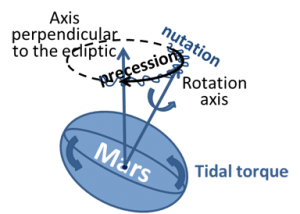 Changes in Mars’ orientation can be divided into two components: precession and nutation. Precession describes the long-term trend of the orientation changes in space, whereas nutation is the name given to the superimposed shorter-term periodic variations. Precession carries the pole of the planet rotation axis at a uniform rate in an anticlockwise sense along a circle on the surface of the celestial sphere, centered on the normal to the Mars orbital plane (ecliptic). Precession measurements will improve the determination of the moment of inertia (mass repartition) of the whole planet.
Changes in Mars’ orientation can be divided into two components: precession and nutation. Precession describes the long-term trend of the orientation changes in space, whereas nutation is the name given to the superimposed shorter-term periodic variations. Precession carries the pole of the planet rotation axis at a uniform rate in an anticlockwise sense along a circle on the surface of the celestial sphere, centered on the normal to the Mars orbital plane (ecliptic). Precession measurements will improve the determination of the moment of inertia (mass repartition) of the whole planet.
Nutation consists of small deviations on the celestial sphere from this uniform motion, both along the precessional path and perpendicular to it. The resulting path of the pole therefore appears wiggly.
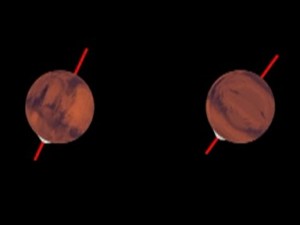
Nutation of Mars with a solid core (left) and a liquid core (right)
Nutation occurs at several periods; the largest of them (at the level of 0.5” 2) has a period of half the orbital period of Mars (687 days in one Martian year). The forced nutation amplitudes depend on the existence of a liquid core and in particular on its size, its density, and shape. Observing nutations allows then to determine core properties and to confirm the liquid state of the core.
The rotation of Mars is approximately uniform, but small variations in the length-of-day (LOD) of less than one millisecond exist, mainly due to seasonal changes in the mass distribution in the atmosphere and to the winds. The most important effect is related to the exchange of CO2 between the atmosphere and the polar ice caps. When more mass is located close to the axis of rotation in the polar caps, Mars will rotate faster, as a skater rotates faster with the arms near his body. Observations of the Martian Length-of-day allow determining the changes in mass redistribution in the atmosphere and polar caps.
Contacts
Véronique Dehant / v.dehant@oma.be / Tel : 02 373 02 66
Tim Van Hoolst / t.vanhoolst@oma.be / Tel : 02 373 06 68
Marie Yseboodt / m.yseboodt@oma.be / Tel : 02 790 39 52
1 The X-band is the part of the electro-magnetic spectrum between approximately 7 and 11.2 GHz, a gigahertz corresponding to one billion of cycles per second
2 1” is 1/3600 of a degree of angle.

